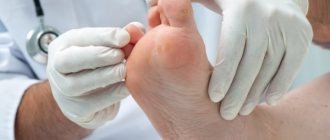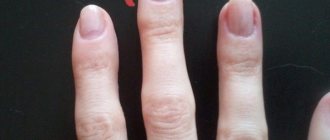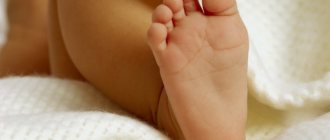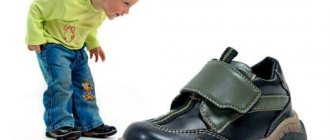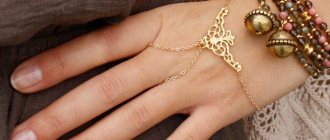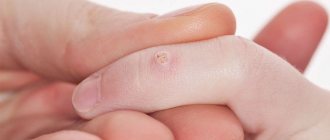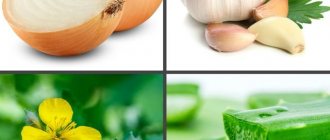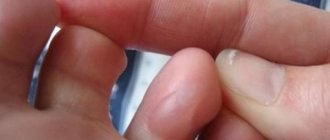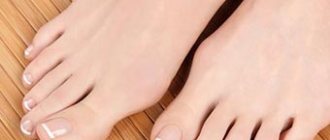There are several main reasons due to which the process of formation of calluses begins on the toes or other areas of the skin of the lower extremities:
- Tight or, on the contrary, too spacious shoes,
- Shoes made from low-quality materials (synthetics)
- High-heeled shoes (increases pressure on the forefoot),
- Lack of vitamin A in the body,
- Flat feet,
- Problems with excess weight,
- Foot injuries
- Ignoring basic rules of foot hygiene.
Usually, calluses appear in the form of small blisters with lymph; their treatment is not difficult; the main thing is not to try to eliminate the problem mechanically (pierce, rip, etc.), since this method will not help in any way, and will even worsen the situation; there is a possibility of introducing an infection into the wound . If, after all, the bubble has been torn off, then in its place gradual necrosis of the skin begins and a dry callus in the form of a lump is formed. It is quite easy to recognize: the lump has clear boundaries and a yellowish-white hue, consisting of compacted layers of keratinized skin. Treatment here must be carried out as carefully as possible in order to prevent complications: dry skin of the corns may begin to crack, and this will be accompanied by bleeding and pain, and the calluses may also develop a root. In this case, the lump itself will be a source of discomfort or pain.
Types of calluses
When choosing how to cure a callus on your toe, you need to take into account the type of tumor.
The following subspecies are distinguished:
- water;
- dry;
- corns;
- core callus.
Each variety has a number of distinctive characteristics. Treatment and care directly depend on the type of tumor.
Water callus
A water callus on the leg is a fluid-filled neoplasm. The bubble is located under the top layer of the skin. The liquid can be transparent or yellowish. It acquires a bloody color after touching the capillary. Water calluses on the foot are one of the most painful.
The formations themselves do not pose a danger to the health and performance of the entire organism. The exception is blood tumors. There is a risk of infection in the body.
The formations cause inconvenience when walking. Causes severe discomfort. With further traumatic exposure, the growth is converted into a dry form. A large layer of keratinized skin appears.
Callus
The callus between the fingers is often core-like . Also occurs on the foot. The main characteristic of the neoplasm is a depression in the center, in which there is a base - a rod, which is easy to see even from the photo. The difficulty of treatment arises precisely because of the presence of the basis of the neoplasm.
There can be many rods. This callus is popularly called chicken callus or jolka . People who are sick develop many complexes due to growths.
It is not recommended to treat a callus on the foot at home. This is fraught with a number of complications. If the patient began treating calluses on the toes late or ignored the need for therapy, the painful sensation will intensify. Microcracks will appear on the keratinized skin.
Most often, rod formations are localized near the toes and hands, as well as near the knees, elbows and other parts of the body.
Dry callus
Dry calluses on the feet are not a type, but one of the stages of growth development. The neoplasm appears after a soft callus. Formed as a result of prolonged friction of the epidermis. Dry calluses on the feet can appear even after light but constant exposure to the skin. The affected area gradually becomes rougher. Dry calluses on the fingers are often found by artists or people who have to write a lot.
Often patients are not interested in how to treat a callus on the foot. This is due to the fact that there is no painful syndrome during formation. Only when microcracks appear does discomfort occur.
One of the types of dry calluses on the heels is corns . With such a lesion, there is a large area of keratinized skin. There are no pronounced boundaries. Localized on the sole. It can also appear on the fingertips. The corns are completely painless. This neoplasm appears extremely rarely on the hands.
Are people with this pathology allowed into the army?
Conscription into the active army is accompanied by an examination of young men who, by age, are subject to military service. The “Regulations on Military Medical Examination” contain articles 68 and 69, which describe foot diseases with different degrees of deformation and complications. The medical commission follows the instructions of this document.
“Planovalgus foot” and “severe curvatures in which a soldier cannot use standard footwear” are included in paragraph “a”. “Moderate deformation” – in point “c”.
During examination and treatment, the irreversibility of changes must be proven. The angle of deflection of the finger and complications matter.
The decision to hire a young person or not depends on the completeness of the submitted documents and extracts from medical institutions. It is worthwhile to restore all information in advance, starting from childhood, if the young man has been operated on.
The appearance of a bunion on the leg requires finding out the cause and starting treatment procedures. Lack or refusal of therapy leads to irreversible consequences and affects the entire musculoskeletal system.
Causes of growth
Calluses on the heels are a normal reaction of the body. The neoplasm appears when it is necessary to protect a certain area of the body. This is a reaction to constant friction or pressure.
The stratum corneum is formed from dead cells. This is a consequence of pressure on sensitive skin. The callus protects the damaged layer from subsequent injury. Formation appears on the legs quickly.
Important! Regenerative processes occur under the callus.
Shoe calluses most often appear:
- when purchasing an uncomfortable new pair with the hope that it will wear out;
- wearing shoes with narrow toes;
- use of summer shoes with straps that fit tightly around the foot;
- wearing shoes with high heels.
It is advisable to get rid of shoes as quickly as possible. Poor quality models will only aggravate the situation if worn further. It is often necessary to treat calluses on the feet after changing winter shoes to spring ones. In the off-season, the risk of neoplasms increases. The reasons for the appearance of formation include the use of shoes made of artificial materials. It stops the access of oxygen. Excessive sweating occurs.
The reasons include not only poor-quality and uncomfortable shoes.
Treatment of calluses on the feet may be necessary for the following provoking factors:
- hard seam on tights;
- walking barefoot;
- lack of vitamins in the body;
- fungal infections.
The likelihood of skin formations is increased in military personnel who are forced to wear uncomfortable shoes or people who are constantly on their feet. This is a natural reaction of the skin in an area of increased discomfort.
Hard buds
What to do if a hard lump appears on your foot? First of all, it is necessary to understand what led to the formation of the outgrowth. There are many reasons for its appearance. But the most basic ones are presented:
- Genetic abnormalities;
- Inflammatory process in the joint capsule (bursitis);
- Problems in the endocrine system;
- Arthrosis of articular joints;
- Osteoporosis, causing fragility and deformation of bone tissue;
- Exostosis, leading to the appearance of bone and cartilage growths;
- Transverse flatfoot, causing divergence of the metatarsal bone.
A seal on the sole may appear due to untreated injuries of the lower extremities, congenital deformation, or after suffering from certain diseases affecting muscles and nerve fibers. It could be paralysis or polio.
A growth can also appear due to wearing narrow, uncomfortable shoes. To avoid the development of such bone formation, it is necessary to avoid high-heeled shoes with narrow toes, as they place an uneven load on the foot. As a result, the anterior plantar region becomes deformed, which leads to the appearance of a growth on the bottom of the foot.
If you notice a callus-like growth that has begun to grow, be sure to visit an orthopedist and undergo diagnostics, because only in this way will the doctor be able to make the correct diagnosis and prescribe appropriate therapy.
If the appearance of a neoplasm is ignored, the disease will begin to progress, leading to such serious pathologies as destruction of bone and cartilage tissue and constant lameness. In this case, surgical intervention cannot be avoided and after it the patient will have to rehabilitate for several months.
The emerging pathological changes when a tumor appears on the foot are easy to notice. They are most often located on the side or top of the sole or below. The appearance of such a growth indicates the development of the initial stage of hallux valgus. Over time, the growth may begin to itch and turn red, the leg will swell in the foot area, pain will appear, thickening of the epidermis and calluses will appear, the affected area will become hot, and movements in the joints will be constrained.
A neoplasm on the lateral part of the sole occurs as a result of external protrusion of the metatarsal bone, affecting the formation of a seal on the phalanx of the big toe. When wearing shoes, the growth is compressed, which leads to discomfort and pain not only when walking, but also at rest.
Symptoms
Common and core calluses on the feet have a set of symptoms. The callus hurts constantly. Present discomfort rarely subsides.
Additional symptoms include:
- seals with a yellow tint;
- roughness at the site of the lesion;
- swelling;
- inflammation of nearby tissues;
- decreased sensitivity in the affected area.
The callus hurts intensely when pressed. Liquid may be present inside the formation. Neoplasms can be both large and small.
A callus on the foot affects the deep layers of the skin. If you look closely, you can find a rod. The disorder causes pain even at rest.
How to distinguish from corns
Corns are formations on the skin without a core. They can remain on the body for years. All this time they cause severe pain and burning. Another difference is the presence of a clear outline at the callus.
An important difference between growths is size. The corns are many times larger.
Pharmaceutical agents in the fight against calluses on the toes
Products in this category are sold in any pharmacies. The most commonly used are ointments or adhesive plasters. It is important that both have a softening effect and a healing effect; this helps speed up the process of callus removal.
The technology for using both products is very similar: you should apply an adhesive plaster to the problem area of the skin or lubricate it with ointment, then fix it and wear it for 2 days. Just like with traditional medicine, several sessions may be required.
The most popular ointments:
- Super Antimozolin,
- Stop callus,
- 5 days.
The most popular adhesive plasters:
- Compeed,
- Leiko,
- Super Antimozolin,
- Salipod.
Complications
You need to learn how to treat calluses. You can’t hesitate when dealing with growths. There is a risk of complications. The attending physician will conduct a diagnosis and select the most appropriate treatment. The most dangerous callus is one with a blister, as there is a risk of infection.
When a blister becomes infected, the area around the formation turns red. Severe swelling appears. The fluid inside the tumor becomes cloudy. There is a risk of cloudy discharge. The patient's body temperature rises. The pain makes it difficult to move and makes itself felt even at rest. If the patient does not learn in time how to treat a wet callus, sepsis begins and a visit to a surgeon is required.
Regardless of the type of lesion, a callus between the toes and on the foot can lead to:
- inflammatory process, which significantly reduces the quality of life;
- infection of the damaged area;
- damage to nearby tissues;
- constant aching pain;
- bleeding of the damaged area.
Corns in children are the most dangerous. At a young age, the body is just developing and cannot resist illnesses. The likelihood of complications developing is high.
Contraindications to the treatment of children's corns
When treating corns, your baby may not like the process of taking baths or compresses. Parents should understand: the child is uncomfortable with the process or is reacting to the effect of the medication. Perhaps he feels allergic reactions in the form of burning, tingling, swelling. If the baby does not like the process of steaming or tickling from the pumice stone, parents should show their imagination and play out the treatment as an interesting adventure. If the mother notices allergic reactions to the applied product, it should be changed after consulting a doctor.
If corns appear on the feet of children, treatment can be avoided by examining children's feet daily for redness and chafing, carefully massaging them before bed. Mother's hands and baby cream will return softness and tenderness to the child's feet.
Diagnostics
You need to decide how to treat a wet callus only after diagnosis. Doctors conduct an external examination. Additionally, palpation is required. Usually no additional examinations are required.
It is also important to establish the true cause of the violation. Sometimes the deviation is due to internal pathologies. First of all, the doctor will pay attention to the shoes the patient is wearing. If it's not about shoes, the doctor will find out about work activity and physical activity.
Of the instrumental techniques, an x-ray examination of the foot is necessary. This is necessary when the doctor suspects a foot deformity or a disease of the musculoskeletal system. When determining how to treat a water callus, you may need to consult a rheumatologist or orthopedist.
Important! A medical history is required. The doctor is looking for a connection between the callus and possible pathologies of metabolic processes.
What to do if your child has corns? Diagnosis, treatment, prevention
Kids love to run barefoot - it's good not only for the immune system and the development of bones and muscles, but also for the nervous system.
But there are also troubles behind this. As soon as a child begins to actively walk and run, his legs are exposed to various external factors.
Even babies can have problems with the skin of their feet. Especially during the period when they start running or playing sports. It’s not surprising - their skin is thinner and more delicate than that of adults.
Why do children get corns? What is useful for parents to know about the causes, treatment and prevention of these formations?
Treatment with drugs
Calluses on the feet as a result of wearing uncomfortable shoes can be treated with medication. The appropriate drug is selected by the doctor, taking into account the individual characteristics of the body. The doctor also takes into account the type of pathology.
Only a correctly selected drug will not harm health and activates regenerative processes.
Salicylic acid
Creams and ointments are prepared based on salicylic acid. They are the most effective way to treat calluses on the heel. The substance burns damaged skin. Before applying the product, apply it to a patch on steamed skin. First you need to cut out the middle in it. This will prevent the medication from coming into contact with healthy skin.
Use products with salicylic acid 1-2 times a day. The most common drugs include Namozol, Collomakk, Salipod. The medication helps treat calluses on the heel and other parts of the foot.
Collomaccus Salipod Namosol
Lactic acid
This acid is less aggressive than salicylic acid. The callus on the sole is spread with a thick layer of the product. The growth is covered with a bandage. The product removes the damaged area. After 2 hours, you need to remove the dead skin with a spatula. Residues are washed off with warm water.
It is enough to use the product for 1-2 days. Popular medications based on lactic acid include Green Pharmacy and Super Anticorn.
Super Anticorn Green Pharmacy
Sodium hydroxide
When choosing how to treat a callus on the little finger, preparations containing sodium hydroxide are chosen last. The medication is aggressive. Quickly eats away damaged epithelium.
Treatment of corns in children
Children's skin readily absorbs substances that fall on it; any seals on the feet easily respond to treatment. Children willingly take baths with decoctions of medicinal herbs.
| Active substance | Recipe |
| Soap and soda bath | Dissolve 1 teaspoon of baking soda in 1 liter of soapy water and keep the feet in the water for 15-20 minutes. |
| Sage | 3 tbsp. Steam spoons of the plant in 2 liters of water, add 2 tbsp. spoons of soda, steam the legs for 20 minutes. |
| Chamomile | 6 tbsp. Brew a tablespoon of dry plant with 2 liters of boiling water, leave for 2 hours, steam for 20 minutes. |
| Celandine | 2 tbsp. Infuse spoons of dry herbs in 1 liter of boiling water for an hour, steam the legs for 15-20 minutes. |
It is better to take baths in the evening, before bedtime. After the procedure, the corns are treated with pumice or a nail file. Then you need to wipe the legs dry and apply cream. When going to bed, put on warm socks. Compresses made from available products will help remove corns and soften the skin on the soles.
| Active substance | Recipe |
| Aloe | Cut the plant leaf lengthwise and secure it to the seal with adhesive tape. |
| Honey or propolis | Apply the product to clean feet, put on a plastic bag and a warm sock. |
| Lemon juice | Apply a slice of lemon to the rough area, secure it with a band-aid, wrap it with polyethylene on top and put on a sock. |
| Fresh cranberry juice | Wet a bandage with juice and apply it to the rough area, wrap it with cling film on top or put on a plastic bag and sock. |
| Onion peel compress | Boil the onion peels in a small amount of water for 15 minutes to form a thick paste. After cooling, apply it to the affected area, protecting the skin around it with a thick layer of rich cream, put on a plastic bag and a warm sock. |
There are many pharmaceutical products that are effective and have no contraindications for children.
| Active substance | Recipe |
| Salicylic acid/ointments, creams based on it | Lubricate the skin around the corns with rich baby cream, use the product strictly in accordance with the instructions. If a burning sensation occurs, remove the substance by rinsing it off in running water. |
| Plasters | The patch is cut to the size of the growth, glued, it is necessary to remove the top layer of callus daily if it was not possible to eliminate the problem at one time. In most cases, a single use to treat dry corns in a baby is enough to get rid of the problem. |
| Aspirin | Crush 1 pack of tablets into powder, dilute with water to a thick paste, add 1 tbsp. spoon of lemon juice. Apply the product for 20 minutes under cling film and a warm sock. After use, rinse, clean the callus with pumice and lubricate with baby cream. A course of treatment of up to 2 weeks is allowed. |
Surgery
When deciding how to quickly treat a callus, sometimes you need to choose surgical treatment. Surgery is required when other methods have not given the expected result.
Most often, drilling is recommended. In order to get rid of the violation, the doctor selects the required cutter size. The doctor carefully drills out the rod. At the same time, it is important not to touch healthy tissues located around.
After drilling, the doctor instills specialized medications into the hole. This will speed up healing and prevent infection.
Another method used is laser removal. The doctor uses a high-frequency laser. After removal, the area is treated with medications.
Cryotherapy is used in a hospital setting. Chicken callus goes away after exposure to cold. The doctor treats the affected area with liquid nitrogen. There will be no trace of the callus left. Instead of a growth there will be beautiful new skin.
Cryotherapy is a reliable and safe method. The only contraindication is inflammation. The doctor will have to first eliminate the inflammatory process and then resort to cryotherapy.
Folk remedies
At the initial stage, you can get rid of the growth using folk methods.
There are several effective methods:
- Aloe compress. Relieves pain and swelling. Eliminates the inflammatory process. To use, remove the outer skin from the sheets. The pulp is applied to the affected area. It is fixed with a bandage. The sheet is changed once a day.
- Chamomile and calendula decoction. You need to mix the raw materials in equal quantities and add water. The liquid is brought to a boil and left for 2 hours. A sterile cloth is soaked in the liquid and placed on the area with growths. This will soothe the skin and activate the recovery process.
- Foot baths. Feet should be steamed in water with the addition of oak bark. This will speed up the regeneration process. The skin will become more resistant to negative influences. The procedure is repeated daily for 5-15 minutes. The main thing is that the water has an average temperature and is not hot.
- Garlic compress. The vegetable is crushed and made into a paste. It is used as a compress.
Before using any unconventional methods, consult a doctor. Any natural component can provoke an allergic reaction. The doctor will help make sure there are no contraindications. The doctor will tell you how to treat water callus safely and effectively.
Important! Non-traditional treatment is effective in combination with traditional treatment.
Prevention
It is easier to prevent any illness than to deal with the consequences later. In this case, callus is no exception. In order to avoid the occurrence of calluses, it is enough to follow simple rules:
- Protect the skin of your hands from mechanical influences. Since chafing of the skin is the most common cause of calluses, you should use gloves during physical labor.
- At the end of physical labor, hands should be thoroughly cleaned and moisturizer applied .
- The use of special protective hand creams creates a protective film that prevents dirt from penetrating into the pores of the skin, so such creams should not be neglected.
- Once every one or two weeks, give your hands a holiday with baths with the addition of sea salt or special solutions .
At first glance, calluses are a minor manifestation of physical labor. However, they can quite easily significantly reduce the quality of life if, for example, severe pain is felt when bending the fingers. You shouldn't endure this kind of pain.
If you do not know how to get rid of such a scourge, then you should contact a specialist. You should not think that a callus is a trivial reason for such treatment.
A neglected callus is quite capable of becoming chronic or taking root deep into the epidermis, which can lead to serious consequences.

